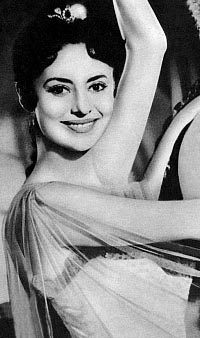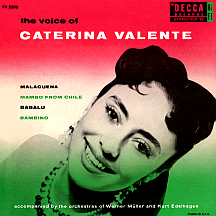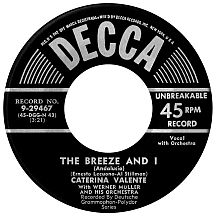CATERINA VALENTE
The Breeze and I
The great composer Ernesto Lecuona was a teenage prodigy, having written several musical pieces, some that would classify as opera or ballet, before reaching the age of 18 in 1913. The first recordings by the Havana-born pianist were made in New York in 1916, leading to his eventual notoriety as arguably the most important Cuban composer and musician of the 20th century; a gradual inclination towards the popular field made his better-known works, moreso than the composer himself, familiar to most Americans while his fame rose to extraordinary levels across the globe. His later contributions to film resulted in an Oscar nomination in 1942 (for the song "Always in My Heart," with lyrics by Kim Gannon, from the film of the same title). His most famous achievement had already come 14 years earlier: "Andalucia" (named after the southern region of Spain) incorporates Latin rhythms in a classical suite that includes the magnificent "Malagueña" and a sequence with added lyrics in Spanish by Emilio de Torre, later made famous by way of an English language rewrite by Al Stillman as "The Breeze and I." For these and other works, Lecuona was nicknamed "The Cuban Gershwin."
In 1940, bandleader Jimmy Dorsey's adaptation of "The Breeze and I," with vocals by Bob Eberly, was a major hit, establishing the Lecuona melody as a standard in America. In 1955 it served as a benchmark in the long, diverse career of Caterina Valente, 24 at the time, an Italian born in Paris, France, who lived in Germany for many years and had her greatest success there. Growing up to the constant presence of father Giuseppe Valente's accordion playing, she took up guitar and became quite adept but didn't necessarily feel it would lead to a lifelong career. In 1952 she married Gerd Eric Horst Scholz (a German juggler known professionally as Erik van Arno) and he encouraged her to follow a show business path, seeing and hearing what perhaps she couldn't.
Doors opened easily for the pretty guitar-playing mezzo soprano. Germany's Polydor Records signed her in 1954 and she was immediately successful performing Schlager music (a characteristically German brand of romantic song) as a commercial alternative to mining classical masterworks for pop adaptations. German composer and conductor Werner Müller, a longtime orchestra leader on RIAS radio in Berlin, supplied the musical arrangements for all of Valente's early efforts; in England and America her recordings appeared on Decca. Lecuona's "Malagueña," sung in German, was her first release in the U.S. in late 1954 and made enough of a commotion to gain her a spot on NBC variety series The Colgate Comedy Hour, where host Gordon MacRae introduced her as "The Malagueña Girl." She could just as easily have been called "The Andalucia Girl" as her next single originated from the same musical masterpiece.
Vic Damone had already sought to revive "The Breeze and I" a year earlier, but it was the Valente version that connected; Werner Müller's arrangement evokes a sweeping, latitudinal Latin essence with English vocals by Caterina reminiscent of the early '40s period of Dorsey's version, adding a final minute of coloratura acrobatics by the multinational singer. Appearing on the U.S. charts in April 1955, it landed in the top ten the following month. A new nickname, The Hi-Fi Nightingale, emerged as the title of her debut album. Numerous television appearances and many popular albums (but no further hit singles) added to her celebrity and made her a household name during the latter half of the 1950s. Müller, who had made his own records in Europe under the seemingly random pseudonym Ricardo Santos, enjoyed a series of releases on the Decca label under his own name after Caterina's hit established him in America.

A joyful sound spread across Europe: Caterina's early Deutschland hits celebrated romance in France, love boats and sunshine. "Ganz Paris Träumt von der Liebe" (Cole Porter's "I Love Paris"), "Steig in das Traumboot der Liebe" (a duet with her brother, Silvio Francesco) and "Wo Meine Sonne Scheint" were all number one hits there between 1955 and 1958. In her native France she hit big with "Bimbombey" (known in the States by Jimmie Rodgers), winning the Grand Prix du Disque, the nation's top music award. In the boot-shaped nation her hits included Italian language versions of "No Arms Can Ever Hold You," "Till" and Lloyd Price's signature song, "Personality." At about the time of her "Malagueña" breakthrough she made her film debut with a small part in Mannequins for Rio (titled They Were So Young in the U.S.), a sensationalistic low-budget crime drama made jointly by German and American companies and featuring a pre-Perry Mason Raymond Burr. After that she starred in a dozen or so German-made romantic comedies and musicals through the early 1960s including Here I Am, Here I Stay in '59, where she threw caution to the wind, performing "Vive Le Rock and Roll" with stateside labelmates Bill Haley and his Comets.
In the late '50s she left Decca for RCA Victor. With Müller still at the musical helm, her recording of "La Strada Del' Amore" ("The Street of Love") garnered a Grammy nomination in 1959 (the second year of the award's existence) in the category Best Vocal Performance, Female (she lost to Ella Fitzgerald, an early NARAS favorite). As the '60s began, she focused on her more widespread acceptance by German fans, making regular appearances on TV in that country and appearing in one final theatrical film in 1962, the farcical comedy Snow White and the Seven Jugglers.
Returning to the United States, she starred in a weekly CBS variety series, The Entertainers, with co-hosts Carol Burnett and Bob Newhart, debuting in the fall of 1964. Newhart left at the end of the year; Carol and Caterina carried on from January 1965 until the show ended in March (Burnette attained TV superstardom with her own high-rated CBS show beginning in the fall of 1967). Caterina, who had done a guest shot on ABC's The Hollywood Palace in May 1964, appeared again in September '65 and hosted an installment in December. The following year she began her own series of variety specials back home in Germany, while shuttling back and forth for numerous appearances on NBC's The Dean Martin Show, the effervescent Dino counting himself among her biggest fans. For the most part, Caterina Valente fell off the American radar when the 1960s ended but continued performing around the globe for decades afterward, displaying an artistry that is nothing less than spectacular.



